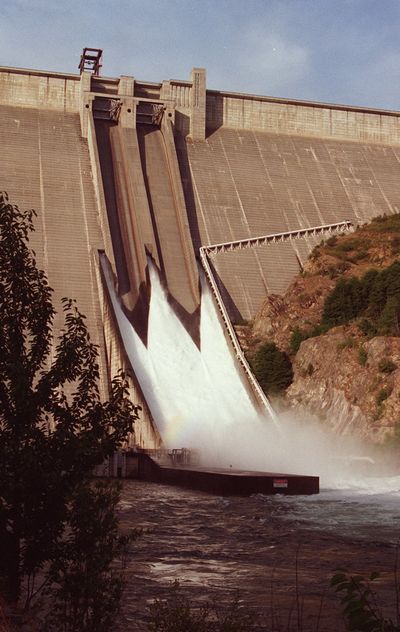UI posts dam files online
Archives reveal spirited debate over Dworshak project

LEWISTON – Some predicted that salmon and steelhead runs would be wiped out, bountiful big-game herds would crash and a beautiful canyon would be turned into a mud-lined reservoir.
Others said a gorgeous lake would be born, downstream floods would be a thing of the past and a recreational playground would bring economic stability to a rural outpost.
In the end the pro-dam forces won the argument. But when the millions of yards of concrete dried and the North Fork Clearwater River backed up behind a new dam at Bruces Eddy, neither side could claim to have been 100 percent accurate in their forecasts.
The predictions and public debate that preceded construction of the project that would later be named Dworshak Dam and Reservoir are preserved in the University of Idaho’s Special Collections and Archives. The university recently made hundreds of the letters, newspaper clippings and photographs of and about the project available in an online archive.
History eventually proved opponents correct, to a degree. The dam did wipe out a wild steelhead run, but its genetics live on in hatchery fish produced below the dam. Important winter elk range was swallowed by the reservoir but the herd was not wiped out. The dam and reservoir helped control flooding but it didn’t prove to be a mecca to recreationists as supporters hoped.
The archives show those who argued against its construction were regarded as wildlife-loving cranks standing in the way of progress.
“If Bruces Eddy is going to hurt fish and wildlife resources a great deal, we (the Corps of Engineers) would be hesitant about giving it our full hearted support,” Gen. E.C. Itschner was quoted in the Lewiston Morning Tribune as he addressed civic leaders at Orofino in July 1958, prior to the project gaining approval. “And I have testified before Congress that there is no truth in the opposition. They (opponents) are not fair or they are completely ignorant. It would cause infinitesimal damage.”
Orofino Mayor A.B. Curtis said the dam would be a tourism draw and described those opposed to it as obstinate.
So it was for those who tried to stop the dam at Bruces Eddy. They were heard and then dismissed. The dam, which would later be named after Idaho Sen. Henry Dworshak, was completed on the North Fork Clearwater River in 1972. It protects downriver communities like Portland and Vancouver, Wash., from flooding and produces power for the grid, but the promise of local economic blessings has yet to fully come to fruition.
The public debate preceding its approval, as well as the construction of the dam, was preserved by Curtis, who was one of the project’s biggest boosters. His collection of photographs and documents was donated to the University of Idaho and was recently digitized along with other archives, which are now available to anyone with access to the Internet.
Officials at the University of Idaho Library identified the collection as both interesting and highly used by students and other researchers, and singled it out to be preserved electronically.
“We digitized all the correspondences and the photos and the other related literature,” said Devin Becker, UI digital initiative librarian.
The photographs are the candy of the collection. Pictures of the lower North Fork prior to the dam and images detailing the immensity of the structure and the wonder of its construction draw in the viewer. Just as remarkable, though, are the letters, newspaper clippings and other documents that provide extraordinary details into the culture and viewpoints of the government and public during the height of America’s dam-building era.
At the same time the Bruces Eddy project was under consideration, there also was a proposal to build a dam at Penny Cliffs, east of Kooskia on the Clearwater River, and three competing proposals to build more dams on the Snake River in Hells Canyon. If all of them had been constructed, including one below the mouth of the Salmon River, wild salmon and steelhead runs in Idaho might now be a relic of history.
Opponents of the dam correctly predicted that plugging the river at Bruces Eddy would wipe out steelhead and salmon runs. The North Fork strain of steelhead, known for large fish, lives on through Dworshak National Fish Hatchery, but an entire sub-basin of prime spawning habitat was lost. Critics also said the dam would destroy winter range used by the Clearwater Basin’s famed elk herd. They proved right on that count as well.
Supporters maintained the dam would create a wonderful lake ringed with cabins and brimming with fish and fishermen. It does support popular bass and kokanee fisheries today, but visitation suffers because of something neither critics nor proponents could have foreseen: The lake is lowered 80 feet every summer.
The reservoir was supposed to be drawn down in the winter, as water was shot through turbines to produce power to heat homes and businesses. And it was for many years. But as salmon and steelhead populations in the rest of the Snake River basin dwindled, Dworshak’s water was called to cool the Snake and flush young fish seaward.
Curtis hoped the dam would be a boost to Clearwater County’s meager tax base. He and other supporters said those against the dam were not local and their arguments should be dismissed. But the foes did include prominent leaders in the hook-and-bullet crowd, both in Lewiston and across the United States.
“We really wanted to show both sides of it, and Curtis’ collection does,” Becker said. “There is even some mild hate mail. It’s mild, very polite.”
In addition to newspaper clippings, the collection includes letters between Curtis and Dworshak, with the mayor urging on the senator and the senator explaining the legislative realities to the mayor.
“We think of it as historical digital scholarship on the Web that hopefully will bring more researchers to the university and allow them to use our collections from a distance,” Becker said.